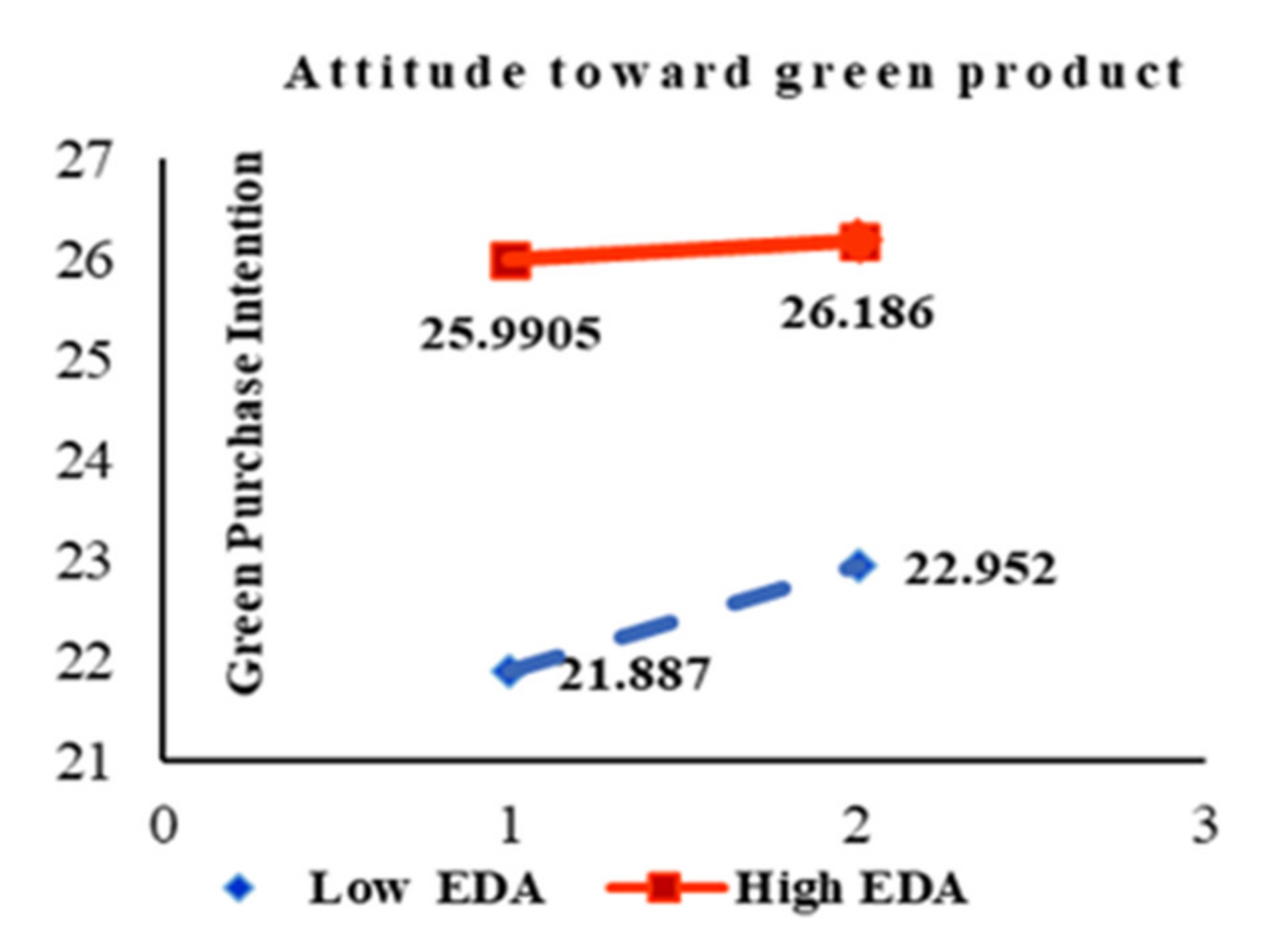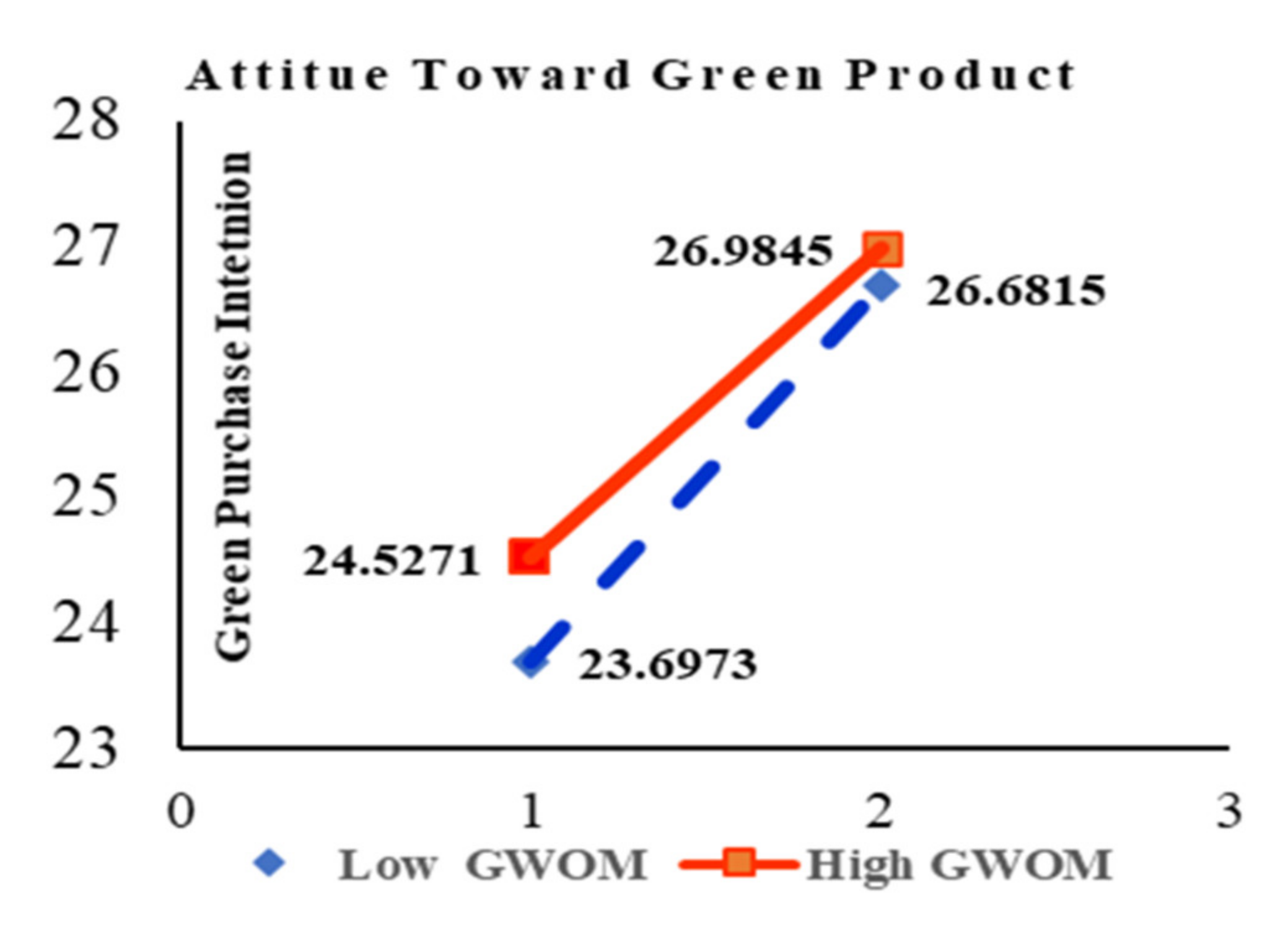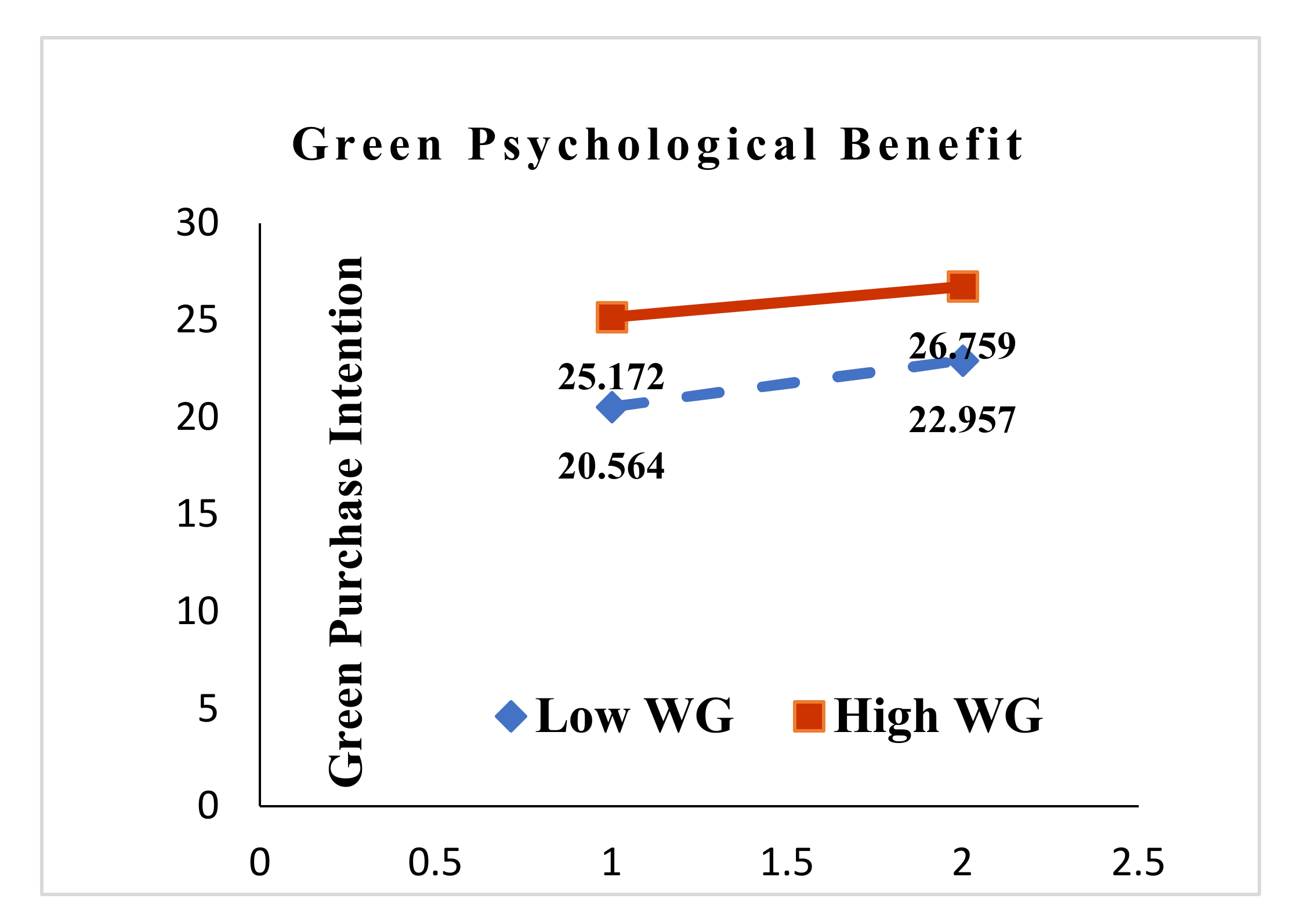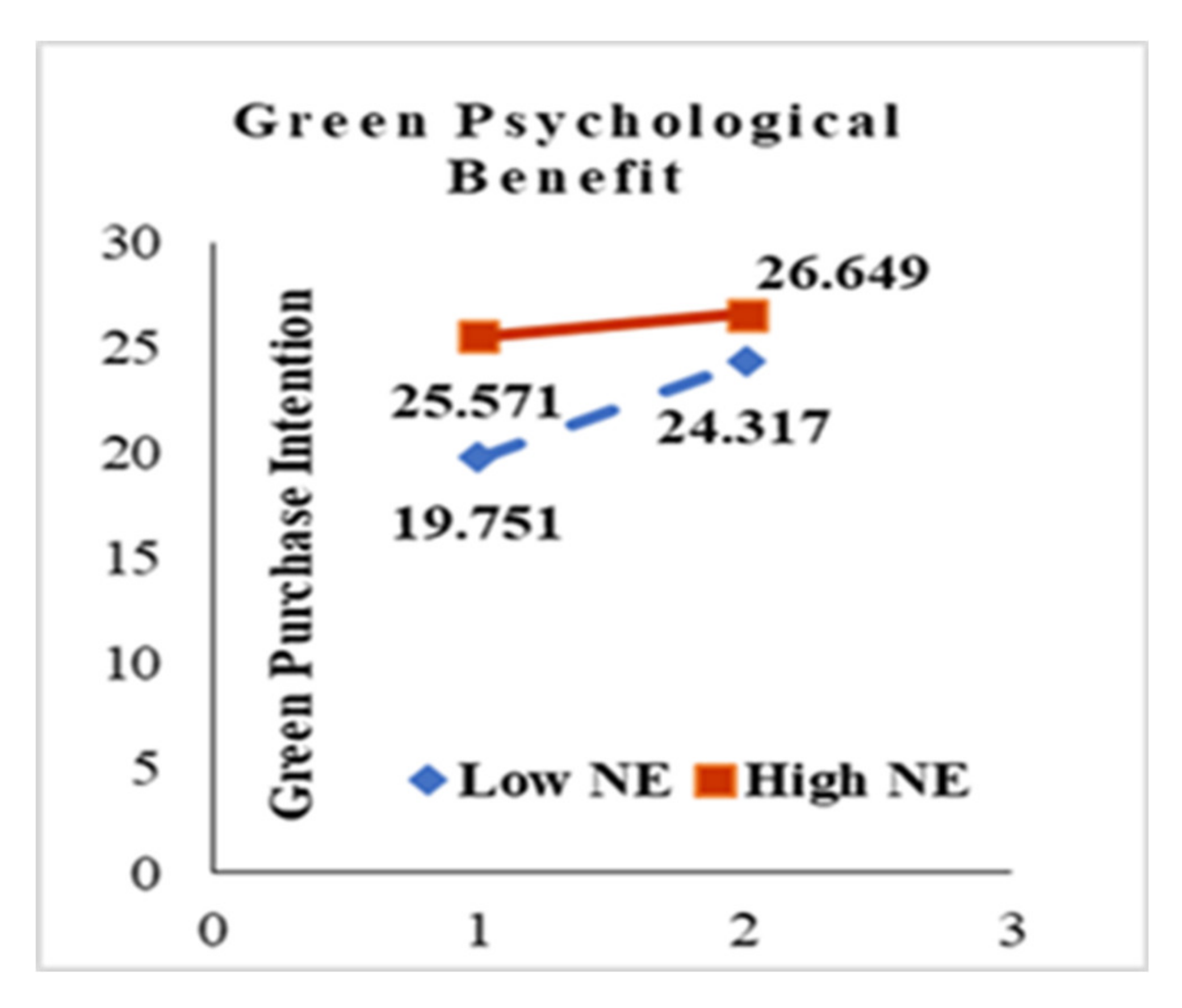Examining the Moderating Effects of Green Marketing and Green Psychological Benefits on Customers’ Green Attitude, Value and Purchase Intention
Abstract
1. Introduction
2. Theoretical Background
2.1. Signaling Theory Approach to Green Marketing
2.2. Attitude-Behavior-Context (ABC) Theory
3. Literature Review and Hypotheses Development
3.1. The Relationship between Green Customer Values and Attitude towards Green Product
3.2. The Relationship between Attitude towards Green Product and Green Purchase Intention
3.3. Green Customer Value and Green Purchase Intention
3.4. The Moderating Effect of Green Marketing
3.5. The Moderating Effects of Green Psychological Benefits
4. Research Design and Methodology
4.1. Research Framework
4.2. Constructs Measurement
4.3. Sampling and Data Collection
5. Data Analysis and Results
5.1. Direct Effects
5.2. Analyzing the Moderating Effect of Green Marketing
5.3. Analyzing the Moderating Effect of Green Psychological Benefit
6. Conclusions
7. Theoretical Implications
8. Managerial Implications
9. Limitation and Future Research Directions
Author Contributions
Funding
Conflicts of Interest
References
- Sugandini, D.; El Qadri, Z.M.; Kustyadji, G.; Muafi, M. Employee Engagement in Entrepreneurship Management: SMEs Cases. Acad. Entrep. J. 2018, 24, 1–8. [Google Scholar] [CrossRef]
- Lai, K.H.; Cheng, T.E. Just-in-Time Logistics; Routledge: Abington, UK, 2016. [Google Scholar]
- Jaiswal, D.; Kant, R. Green purchasing behaviour: A conceptual framework and empirical investigation of Indian consumers. J. Retail. Consum. Serv. 2018, 41, 60–69. [Google Scholar] [CrossRef]
- Calkins, M. Materials for Sustainable Sites: A Complete Guide to the Evaluation, Selection, and Use of Sustainable Construction Materials; John Wiley & Sons: Hoboken, NJ, USA, 2008. [Google Scholar]
- Vazifehdoust, H.; Taleghani, M.; Esmaeilpour, F.; Nazari, K.; Khadang, M. Purchasing green to become greener: Factors influence consumers’ green purchasing behavior. Manag. Sci. Lett. 2013, 2489–2500. [Google Scholar] [CrossRef]
- Paul, J.; Modi, A.; Patel, J. Predicting green product consumption using theory of planned behavior and reasoned action. J. Retail. Consum. Serv. 2016, 29, 123–134. [Google Scholar] [CrossRef]
- Yadav, R.; Pathak, G.S. Young consumers’ intention towards buying green products in a developing nation: Extending the theory of planned behavior. J. Clean. Prod. 2016, 135, 732–739. [Google Scholar] [CrossRef]
- Kim, H.-W.; Chan, H.C.; Gupta, S. Value-based Adoption of Mobile Internet: An empirical investigation. Decis. Support Syst. 2007, 43, 111–126. [Google Scholar] [CrossRef]
- Schena, R.; Netti, G.; Russo, A. Consumers’ Behavior toward Green Products: A Signalling Theory Approach. Int. J. Bus. 2015, 6, 6. [Google Scholar] [CrossRef]
- Kasliwal, N.; Agarwal, S. Green Marketing Initiatives and Sustainable Issues in Hotel Industry. In Green Business: Concepts, Methodologies, Tools, and Applications; Management Association, I., Ed.; IGI Global: Harrisburg, PA, USA, 2019; pp. 512–529. [Google Scholar] [CrossRef]
- Zhao, M.; Xie, J. Effects of Social and Temporal Distance on Consumers’ Responses to Peer Recommendations. J. Mark. Res. 2011, 48, 486–496. [Google Scholar] [CrossRef]
- Chen, Y.-S.; Chang, C.-H.; Yeh, S.-L.; Cheng, H.-I. Green shared vision and green creativity: The mediation roles of green mindfulness and green self-efficacy. Qual. Quant. 2015, 49, 1169–1184. [Google Scholar] [CrossRef]
- Keller, E.; Fay, B. Word-of-Mouth Advocacy. J. Advert. Res. 2012, 52, 459–464. [Google Scholar] [CrossRef]
- Kottler, P.; Amstrong, G. Principles of Marketing, 14th ed.; Pearson Educated Limited: New York, NY, USA, 2012. [Google Scholar]
- Kontic, I.; Biljeskovic, J. Greening the Marketing Mix. 2010. Available online: http://www.diva-portal.org/smash/get/diva2:329044/fulltext01.pdf (accessed on 24 May 2010).
- Aaker, D.A. Building Strong Brands; Free Press: New York, NY, USA, 2002. [Google Scholar]
- Nunes, P.A.L.; Schokkaert, E. Identifying the warm glow effect in contingent valuation. J. Environ. Econ. Manag. 2003, 45, 231–245. [Google Scholar] [CrossRef]
- Allison, T.H.; McKenny, A.F.; Short, J.C. The effect of entrepreneurial rhetoric on microlending investment: An examination of the warm-glow effect. J. Bus. Ventur. 2013, 28, 690–707. [Google Scholar] [CrossRef]
- Hartmann, P.; Apaolaza-Ibáñez, V. Consumer attitude and purchase intention toward green energy brands: The roles of psychological benefits and environmental concern. J. Bus. Res. 2012, 65, 1254–1263. [Google Scholar] [CrossRef]
- Ahmad, A.; Thyagaraj, K.S. Consumer’s Intention to Purchase Green Brands: The Roles of Environmental Concern, Environmental Knowledge and Self Expressive Benefits. Curr. World Environ. 2015, 10, 879–889. [Google Scholar] [CrossRef]
- Hartmann, P.; Apaolaza-Ibáñez, V. Green advertising revisited. Int. J. Advert. 2009, 28, 715–739. [Google Scholar] [CrossRef]
- Mayer, F.S.; Frantz, C.M.; Bruehlman-Senecal, E.; Dolliver, K. Why Is Nature Beneficial? Environ. Behav. 2009, 41, 607–643. [Google Scholar] [CrossRef]
- Batra, R.; Ray, M.L. Affective Responses Mediating Acceptance of Advertising. J. Consum. Res. 1986, 13, 234. [Google Scholar] [CrossRef]
- Connelly, B.L.; Certo, S.T.; Ireland, R.D.; Reutzel, C.R. Signaling Theory: A Review and Assessment; SAGE Publications: Los Angeles, CA, USA, 2011. [Google Scholar]
- Stiglitz, J.E. Capital Market Liberalization, Economic Growth, and Instability. World Dev. 2000, 28, 1075–1086. [Google Scholar] [CrossRef]
- Hussaina, S.; Melewar, T.C.; Priporas, C.-V.; Foroudi, P.; Dennis, C. Examining the effects of celebrity trust on advertising credibility, brand credibility and corporate credibility. J. Bus. Res. 2020, 109, 472–488. [Google Scholar] [CrossRef]
- Guagnano, G.A.; Stern, P.C.; Dietz, T. Influences on Attitude-Behavior Relationships. Environ. Behav. 1995, 27, 699–718. [Google Scholar] [CrossRef]
- Feldmann, C.; Hamm, U. Consumers’ perceptions and preferences for local food: A review. Food Qual. Prefer. 2015, 40, 152–164. [Google Scholar] [CrossRef]
- Goh, S.K.; Balaji, M.S. Linking green skepticism to green purchase behavior. J. Clean. Prod. 2016, 131, 629–638. [Google Scholar] [CrossRef]
- Eggert, A.; Ulaga, W. Customer perceived value: A substitute for satisfaction in business markets? J. Bus. Ind. Mark. 2002, 17, 107–118. [Google Scholar] [CrossRef]
- Tam, J.L.M. Customer Satisfaction, Service Quality and Perceived Value: An Integrative Model. J. Mark. Manag. 2004, 20, 897–917. [Google Scholar] [CrossRef]
- Chen, Y.; Chang, C. Enhance green purchase intentions: The roles of green perceived value, green perceived risk, and green trust. Manag. Decis. 2012, 50, 502–520. [Google Scholar] [CrossRef]
- Schwartz, S.H. Are there universal aspects in the structure and contents of human values. J. Soc. Issues 1994, 50, 19–45. [Google Scholar] [CrossRef]
- Zsoka, A.; Szerenyi, Z.M.; Szechy, A.; Kocsis, T. Greening due to environmental education? Environmental knowledge, attitudes, consumer behavior and everyday pro-environmental activities of Hungarian high school and university students. J. Clean Prod. 2013, 48, 126–138. [Google Scholar] [CrossRef]
- Liobikiene, G.; Juknys, R. The role of values, environmental risk perception, awareness of consequences, and willingness to assume responsibility for environmentally-friendly behaviour: The Lithuanian case. J. Clean. Prod. 2016, 112, 3413–3422. [Google Scholar] [CrossRef]
- Björklund, M. Influence from the business environment on environmental purchasing -Drivers and hinders of purchasing green transportation services. J. Purch. Supply Manag. 2011, 17, 11–22. [Google Scholar] [CrossRef]
- Ledden, L.; Kalafatis, S.P.; Samouel, P. The relationship between personal values and perceived value of education. J. Bus. Res. 2007, 60, 965–974. [Google Scholar] [CrossRef]
- Appolloni, A.; Sun, H.; Jia, F.; Li, X. Green Procurement in the private sector: A state-of-the-art review between 1996 and 2013. J. Clean. Prod. 2014, 85, 122–133. [Google Scholar] [CrossRef]
- Saputra, M.H.; Kristyassari, B.; Farida, N.; Ardyan, E. An Investigation of Green Product Innovation on Consumer Repurchase Intention: The Mediating Role of Green Customer Value. J. Environ. Manag. Tour. 2020, 11, 622–633. [Google Scholar] [CrossRef]
- Ha, H.Y.; Janda, S. Predicting consumer intentions to purchase energy-efficient products. J. Consum. Mark. 2012, 29, 461–469. [Google Scholar] [CrossRef]
- Klöckner, C.A. A comprehensive model of the psychology of environmental behaviour—A meta-analysis. Global Environ. Chang. 2013, 23, 1028–1038. [Google Scholar] [CrossRef]
- Panda, T.K.; Kumar, A.; Jakhar, S.; Luthra, S.; Garza-Reyes, J.A.; Kazancoglu, I.; Nayak, S.S. Social and environmental sustainability model on consumers’ altruism, green purchase intention, green brand loyalty and evangelism. J. Clean. Prod. 2019, 118575. [Google Scholar] [CrossRef]
- Tsen, C.H.; Phang, G.; Hasan, H.; Buncha, M.R. Going green: A study of consumers’ willingness to pay for green products in Kota Kinabalu. Int. J. Bus. Soc. 2006, 7, 40–54. [Google Scholar]
- Huang, Y.-C.; Yang, M.; Wang, Y.-C. Effects of green brand on green purchase intention. Mark. Intell. Plan. 2014, 32, 250–268. [Google Scholar] [CrossRef]
- Chekima, B.; Wafa, S.A.W.S.K.; Igau, O.A.; Chekima, S.; dan Sondoh, S.L., Jr. Examining Green Consumerism Motivational Drivers: Does Premium Price and Demographics matter to Green Purchasing? J. Clean. Prod. 2016, 112, 3436–3450. [Google Scholar] [CrossRef]
- Michaelidou, N.; Hassan, L.M. Modelling the Factors Affecting Rural Consumers’ Purchase of Organic and Free-Range Produce: A Case Study of Consumers’ from the Island of Arran in Scotland, UK. Food Policy 2010, 35, 130–139. [Google Scholar] [CrossRef]
- Fauzan, N.; Azhar, F.N. The Influence of Environmental Concern and Environmental Attitude on Purchase Intention towards Green Products: A Case Study of Students College in Universitas Muhammadiyah Yogyakarta. Available online: https://ssrn.com/abstract=3525917 (accessed on 27 January 2020).
- Amoako, G.K.; Dzogbenuku, R.K.; Abubakari, A. Do green knowledge and attitude influence the youth’s green purchasing? Theory of planned behavior. Int. J. Product. Perform. Manag. 2020. [Google Scholar] [CrossRef]
- Lee, K. Gender differences in Hong Kong adolescent consumers’ green purchasing behavior. J. Consum. Mark. 2009, 26, 87–96. [Google Scholar] [CrossRef]
- Mostafa, M.M. A hierarchical analysis of the green consciousness of the Egyptian consumer. Psychol. Mark. 2007, 24, 445–473. [Google Scholar] [CrossRef]
- Li, M.; Cai, L.A. The effects of personal values on travel motivation and behavioral intention. J. Travel Res. 2012, 51, 473–487. [Google Scholar] [CrossRef]
- Hanaysha, J.R. An examination of the factors affecting consumer’s purchase decision in the Malaysian retail market. PSU Res. Rev. 2018, 2, 7–23. [Google Scholar] [CrossRef]
- Sharma, V.M.; Klein, A. Consumer perceived value, involvement, trust, susceptibility to interpersonal influence, and intention to participate in online group buying. J. Retail. Consum. Serv. 2020, 52, 101946. [Google Scholar] [CrossRef]
- Ashton, A.S.; Scott, N.; Solnet, D.; Breakey, N. Hotel restaurant dining: The relationship between perceived value and intention to purchase. Tour. Hosp. Res. 2010, 10, 206–218. [Google Scholar] [CrossRef]
- Hänninen, N.; Karjaluoto, H. Environmental values and customer-perceived value in industrial supplier relationships. J. Clean. Prod. 2017, 156, 604–613. [Google Scholar] [CrossRef]
- Song, Y.; Guo, S.; Zhang, M. Assessing customers’ perceived value of the anti-haze cosmetics under haze pollution. Sci. Total Environ. 2019, 685, 753–762. [Google Scholar] [CrossRef]
- Koller, M.; Floh, A.; Zauner, A. Further insights into perceived value and consumer loyalty: A “Green” perspective. Psychol. Mark. 2011, 28, 1154–1176. [Google Scholar] [CrossRef]
- Al-Gasawneh, J.; Al-Adamat, A. The mediating role of e-word of mouth on the relationship between content marketing and green purchase intention. Manag. Sci. Lett. 2020, 10, 1701–1708. [Google Scholar] [CrossRef]
- Suki, M.N.; Suki, M.N. Examination of peer influence as a moderator and predictor in explaining green purchase behaviour in a developing country. J. Clean. Prod. 2019. [Google Scholar] [CrossRef]
- Ahmed, W.; Zhang, Q. Green purchase intention: Effects of electronic service quality and customer green psychology. J. Clean. Prod. 2020, 122053. [Google Scholar] [CrossRef]
- Robinot, E.; Giannelloni, J.L. Do hotels’ “green” attributes contribute to customer satisfaction? J. Serv. Mark. 2010, 24, 157–169. [Google Scholar] [CrossRef]
- Ahmad, Y.Y.; Ilkay, K. The impact of content marketing on consumers’ purchase intention for home appliances: A study in Afghanistan. Int. J. Bus. Manag. Invent. 2019, 2319, 38–47. [Google Scholar]
- Fong, K.F. The Moderator Role of Advertisement in Influencing the Purchasing Intention of Recyclable Product. 2015. Available online: http://eprints.utar.edu.my/1620/1/The_Moderator_Role_of_Advertisement_in_Influencing_the_Purchasing_Intention_of_Recyclable_Product.pdf (accessed on 15 January 2015).
- Jaini, A.; Quoquab, F.; Mohammad, J.; Hussin, N. I buy green products, do you…? Int. J. Phar. Health Mar. 2019, 14, 89–112. [Google Scholar] [CrossRef]
- Haytko, D.L.; Matulich, E. Green Advertising and Environmentally Responsible Consumer Behaviors: Linkages Examined. J. Manag. Mark. Res. 2008, 1, 1–11. [Google Scholar]
- Kotler, P.; Keller, K.L.; Ancarani, F.; Costabile, M. Marketing Management, 14th ed.; Pearson: New York, NY, USA, 2014. [Google Scholar]
- Lang, B.; Hyde, K.F. Word of mouth: What we know and what we have yet to learn. J. Consum. Satisf. Dissatisf. Complain. Behav. 2013, 26, 3–18. [Google Scholar]
- Herr, P.M.; Kardes, F.R.; Kim, J. Effects of word-of-mouth and product-attribute information on persuasion: An accessibility-diagnosticity perspective. J. Consum. Res. 1991, 17, 454–462. [Google Scholar] [CrossRef]
- Sweeney, J.C.; Webb, D.A. How functional, psychological, and social relationship benefits influence individual and firm commitment to the relationship. J. Bus. Ind. Mark. 2007, 22, 474–488. [Google Scholar] [CrossRef]
- Oskamp, S.; Harrington, M.J.; Edwards, T.C.; Sherwood, D.L.; Okuda, S.M.; Swanson, D.C. Factors influencing household recycling behavior. Environ. Behav. 1991, 23, 494–519. [Google Scholar] [CrossRef]
- Andreoni, J. An experimental test of the public-goods crowding-out hypothesis. Am. Econ. Rev. 1993, 83, 1317–1327. [Google Scholar]
- Van der Linden, S. Warm glow is associated with low- but not high-cost sustainable behavior. Nat. Sustain. 2018, 1, 28–30. [Google Scholar] [CrossRef]
- Hartmann, P.; Eisend, M.; Apaolaza, V.; D’Souza, C. Warm glow vs. altruistic values: How important is intrinsic emotional reward in pro-environmental behavior? J. Environ. Psy. 2017, 52, 43–55. [Google Scholar] [CrossRef]
- Hwang, J.; Choi, J. An Investigation of Passengers’ Psychological Benefits from Green Brands in an Environmentally Friendly Airline Context: The Moderating Role of Gender. Sustainability 2017, 10, 80. [Google Scholar] [CrossRef]
- Bögeholz, S. Nature experience and its importance for environmental knowledge, values and action: Recent German empirical contributions. Environ. Educ. Res. 2006, 12, 65–84. [Google Scholar] [CrossRef]
- Andereck, K.L.; Nyaupane, G.P. Exploring the nature of tourism and quality of life perceptions among residents. J. Travel Res. 2011, 50, 248–260. [Google Scholar] [CrossRef]
- Edell, J.A.; Burke, M.C. The Power of Feelings in Understanding Advertising Effects. J. Consum. Res. 1987, 14, 421. [Google Scholar] [CrossRef]
- Ajzen, I. The theory of planned behavior. Organ. Behav. Hum. Decis. Process. 1991, 50, 179–211. [Google Scholar] [CrossRef]
- Ivancevich, S.H.; Ivancevich, D.M.; Elikai, F. Accounting software selection and satisfaction. CPA J. 2010, 80, 66. [Google Scholar]
- Clark, C.F.; Kotchen, M.J.; Moore, M.R. Internal and external influences on pro-environmental behavior: Participation in a green electricity program. J. Environ. Psychol. 2003, 23, 237–246. [Google Scholar] [CrossRef]
- Andreoni, J. Giving with impure altruism: Applications to charity and Ricardian equivalence. J. Political Econ. 1989, 97, 1447–1458. [Google Scholar] [CrossRef]
- Menges, R.; Schroeder, C.; Traub, S. Altruism, Warm Glow and the Willingness-to-Donate for Green Electricity: An Artefactual Field Experiment. Environ. Resour. Econ. 2005, 31, 431–458. [Google Scholar] [CrossRef]
- Glazer, A.; Konrad, K. A signaling explanation for charity. Am. Econ. Rev. 1996, 86, 1019–1028. [Google Scholar]
- Leather, P.; Pyrgas, M.; Beale, D.; Lawrence, C. Windows in the workplace. Environ. Behav. 1998, 30, 739–763. [Google Scholar] [CrossRef]
- Maller, C.; Townsend, M.; Pryor, A.; Brown, P.; St Leger, L. Healthy nature healthy people: “contact with nature” as an upstream health promotion intervention for populations. Health Promot. Int. 2006, 21, 45–54. [Google Scholar] [CrossRef]
- Chan, R. Determinants of Chinese consumers’ green purchasing behavior. Psychol. Mark. 2001, 18, 389–413. [Google Scholar] [CrossRef]
- Schroer, J.; Hertel, G. Voluntary Engagement in an Open Web-Based Encyclopedia: Wikipedians and Why They Do It. Media Psychol. 2009, 12, 96–120. [Google Scholar] [CrossRef]
- Hair, J.F.; Ringle, C.M.; Sarstedt, M. PLS-SEM: Indeed, a Silver Bullet. J. Mark. Theory Pract. 2011, 19, 139–152. [Google Scholar] [CrossRef]
- Podsakoff, P.M.; MacKenzie, S.B.; Podsakoff, N.P. Sources of Method Bias in Social Science Research and Recommendations on How to Control It. Annu. Rev. Psychol. 2012, 63, 539–569. [Google Scholar] [CrossRef]
- Harman, H.H. Modern Factor Analysis, 3rd ed.; Revised; The University of Chicago Press: Chicago, IL, USA, 1976. [Google Scholar]
- Hair, J.F.; Sarstedt, M.; Hopkins, L.; Kuppelwieser, V.G. Partial least squares structural equation modeling (PLS-SEM). Eur. Bus. Rev. 2014, 26, 106–121. [Google Scholar] [CrossRef]
- Maichum, K.; Parichatnon, S.; Peng, K.-C. Application of the Extended Theory of Planned Behavior Model to Investigate Purchase Intention of Green Products among Thai Consumers. Sustainability 2016, 8, 1077. [Google Scholar] [CrossRef]
- Ciavolino, E.; Dahlgaard, J.J. ECSI—Customer Satisfaction Modelling and Analysis: A Case Study. Total Qual. Manag. Bus. Excell. 2007, 18, 545–554. [Google Scholar] [CrossRef]
- Blackwell, R.D.; Miniard, P.W.; Engel, J.E. Consumer Behaviour, 10th ed.; Thompson: South-Western, SW, Canada, 2006. [Google Scholar]
- Pirani, E.; Secondi, L. Eco-friendly Attitudes: What European Citizens Say and What They Do. Int. J. Environ. Res. 2011, 5, 67–84. [Google Scholar]
- Van Vugt, M.; Roberts, G.; Hardy, C. Competitive altruism: Development of reputation-based cooperation in groups. In Handbook of Evolutionary Psychology; R. Dunbar & Status, Reputation, and Altruism 403 L. Barrett; Oxford University Press: Oxford, UK, 2007; pp. 531–540. [Google Scholar]
- Griskevicius, V.; Cantú, S.M.; Van Vugt, M. The Evolutionary Bases for Sustainable Behavior: Implications for Marketing, Policy, and Social Entrepreneurship. J. Public Policy Mark. 2012, 31, 115–128. [Google Scholar] [CrossRef]
- Holbrook, M.B. Consumption experience, customer value, and subjective personal introspection: An illustrative photographic essay. J. Bus. Res. 2006, 28, 714–725. [Google Scholar] [CrossRef]
- Kärnä, J.; Juslin, H.; Ahonen, V.; Hansen, E. Green Advertising: Greenwash or a True Reflection of Marketing Strategies? Greener Manag. Int. 2001, 33, 59–70. [Google Scholar] [CrossRef]
- Anderson, J.C.; Thomson, J.B.; Wynstra, F. Combining value and price to make purchase decisions in business markets. Int. J. Res. Mark. 2000, 17, 307–329. [Google Scholar] [CrossRef]
- Andreassen, T.W.; Lindestad, B. The effect of corporate image in the formation of customer loyalty. J. Res. 1998, 1, 82–92. [Google Scholar] [CrossRef]
- Saboo, A.R.; Kumar, V.; Ramani, G. Evaluating the impact of social media activities on human brand sales. Int. J. Re. Mark. 2016, 33, 524–541. [Google Scholar] [CrossRef]
- Kao, T.-F. A Study on the Influence of Green Advertising Design and Environmental Emotion on Advertising Effect. J. Clean. Prod. 2019, 118294. [Google Scholar] [CrossRef]
- De Medeiros, J.F.; Duarte Ribeiro, J.L.; Nogueira Cortimiglia, M. Influence of perceived value on purchasing decisions of green products in Brazil. J. Clean. Prod. 2016, 110, 158–169. [Google Scholar] [CrossRef]
- Vlachos, P.A.; Theotokis, A.; Pramatari, K.; Vrechopoulos, A. Consumer-retailer emotional attachment. Eur. J. Mark. 2010, 44, 1478–1499. [Google Scholar] [CrossRef]
- Baek, T.H.; Kim, J.; Yu, J.H. The differential roles of brand credibility and brand prestige in consumer brand choice. Psychol. Mark. 2010, 27, 662–678. [Google Scholar] [CrossRef]
- Berger, J. Signaling can increase consumers’ willingness to pay for green products. Theoretical model and experimental evidence. J. Consum. Behav. 2019. [Google Scholar] [CrossRef]
- Anderson, J.C.; Gerbing, D.W. Structural equation modeling in practice: A review and recommended two-step approach. Psychol. Bull. 1988, 103, 411. [Google Scholar] [CrossRef]
- Söderlund, M. Customer satisfaction and its consequences on customer behavior revisited. Int. J. Serv. Ind. Manag. 1998, 9, 169–188. [Google Scholar] [CrossRef]






| Construct | AVE | CR | Cronbach’s Alpha (α) | R2 |
|---|---|---|---|---|
| Attitude towards green product | 0.758 | 0.926 | 0.894 | 0.445 |
| Green Customer Value | ||||
| Perceived Value | 0.600 | 0.885 | 0.733 | 0.391 |
| Environment Image | 0.577 | 0.820 | 0.728 | - |
| Green Marketing | ||||
| Environment Advertisement | 0.730 | 0.915 | 0.877 | 0.213 |
| GWOM | 0.658 | 0.795 | 0.775 | 0.390 |
| Green Psychological Benefits | ||||
| Warm Glow | 0.632 | 0.932 | 0.916 | 0.401 |
| Self-expressive Benefits | 0.567 | 0.867 | 0.810 | 0.413 |
| Nature Experience | 0.648 | 0.878 | 0.833 | 0.453 |
| Green Purchase Intention | 0.595 | 0.897 | 0.862 | 0.711 |
| Hypothesis | Path | Standardized Estimate | t-Value | p-Value | Remarks |
|---|---|---|---|---|---|
| H1a | Green customer value → Attitude towards green products | Supported | |||
| Perceived value → Attitude towards green products | 0.540 | 25.291 | *** | ||
| Environmental image → Attitude towards green products | 0.229 | 10.237 | *** | ||
| H1b | Attitude towards green products → Green purchase intention | Supported | |||
| 0.124 | 5.809 | *** | |||
| H1c | Green customer value → Green purchase intention | Supported | |||
| Perceived value → Green purchase intention | 0.242 | 9.346 | *** | ||
| Environmental image → Green purchase intention | 0.326 | 14.157 | *** | ||
| Name of Factor | Low Attitude towards Green Product | High Attitude towards Green Product | F-Value (p) | Duncan | ||
|---|---|---|---|---|---|---|
| 1. Low EAD (n = 14) | 2. High EAD (n = 24) | 3. Low EAD (n = 30) | 4. High EAD (n = 251) | |||
| Green Purchase Intention | 21.887 | 25.990 | 22.9522 | 26.186 | 18.131 (0.000) | 12, 34 |
| Name of Factor | Low Attitude towards Green Product | High Attitude towards Green Product | F-Value (p) | Duncan | ||
| 1. Low GWOM (n = 42) | 2. High GWOM (n = 100) | 3. Low GWOM (n = 48) | 4. High GWOM (n = 129) | |||
| Green Purchase Intention | 23.6973 | 24.5271 | 26.6815 | 26.9845 | 24.057 (0.000) | 12, 34 |
| Name of Factor | Low Green Customer’s Perceived Value | High Green Customer’s Perceived Value | F-Value (p) | Duncan | ||
|---|---|---|---|---|---|---|
| 1. Low WG (n = 22) | 2. High WG (n = 40) | 3. Low WG (n = 24) | 4. High WG (n = 233) | |||
| Green Purchase Intention | 20.564 | 22.957 | 25.1726 | 26.759 | 64.127 (0.000) | 1, 2, 3, 4 |
| Name of Factor | Low Green Customer’s Perceived Value | High Green Customer’s Perceived Value | F-Value (p) | Duncan | ||
| 1. Low SEB (n = 27) | 2. High SEB (n = 41) | 3. Low SEB (n = 9) | 4. High SEB (n = 242) | |||
| Green Purchase Intention | 19.751 | 24.317 | 25.571 | 26.649 | 73.959 (0.000) | 1, 2, 34 |
| Name of Factor | Low Green Perceived Customer Value | High Green Perceived Customer Value | F-Value (p) | Duncan | ||
| 1. Low NE (n = 39) | 2. High NE (n = 29) | 3. Low NE (n = 28) | 4. High NE (n = 223) | |||
| Green Purchase Intention | 21.080 | 24.418 | 24.969 | 26.817 | 66.329 (0.000) | 1, 23, 4 |
© 2020 by the authors. Licensee MDPI, Basel, Switzerland. This article is an open access article distributed under the terms and conditions of the Creative Commons Attribution (CC BY) license (http://creativecommons.org/licenses/by/4.0/).
Share and Cite
Liao, Y.-K.; Wu, W.-Y.; Pham, T.-T. Examining the Moderating Effects of Green Marketing and Green Psychological Benefits on Customers’ Green Attitude, Value and Purchase Intention. Sustainability 2020, 12, 7461. https://doi.org/10.3390/su12187461
Liao Y-K, Wu W-Y, Pham T-T. Examining the Moderating Effects of Green Marketing and Green Psychological Benefits on Customers’ Green Attitude, Value and Purchase Intention. Sustainability. 2020; 12(18):7461. https://doi.org/10.3390/su12187461
Chicago/Turabian StyleLiao, Ying-Kai, Wann-Yih Wu, and Thi-That Pham. 2020. "Examining the Moderating Effects of Green Marketing and Green Psychological Benefits on Customers’ Green Attitude, Value and Purchase Intention" Sustainability 12, no. 18: 7461. https://doi.org/10.3390/su12187461
APA StyleLiao, Y.-K., Wu, W.-Y., & Pham, T.-T. (2020). Examining the Moderating Effects of Green Marketing and Green Psychological Benefits on Customers’ Green Attitude, Value and Purchase Intention. Sustainability, 12(18), 7461. https://doi.org/10.3390/su12187461





